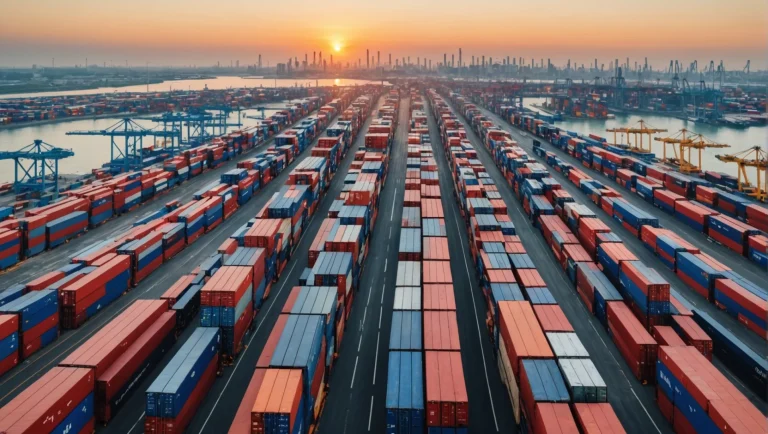You’ve built your dream. Pour your heart, soul, and savings into your small business. But there’s an invisible threat lurking, ready to bring it all crashing down. It’s not competition, not the economy, not even a global pandemic.
It’s your supply chain.
In 2024, supply chain disruptions are the silent assassins of small businesses. They strike without warning, choking off your inventory, inflating costs, and leaving customers frustrated. One day you’re thriving, the next you’re scrambling to keep the lights on.
But here’s the twist: these disruptions aren’t just threats. They’re opportunities in disguise.
The businesses and industries that survive – no, thrive – in 2024 will be the ones that turn supply chain disruption and chaos into their secret weapon. They’ll use strategies so counterintuitive, that most of their competitors won’t even see them coming.
Imagine having a supply chain so resilient, it bends but never breaks. Picture your business not just surviving the next crisis, but emerging stronger while others falter.
This isn’t wishful thinking. It’s the new reality for savvy small business owners who understand the game has changed.
Are you ready to join their ranks? To transform your greatest vulnerability into your greatest strength?
The strategies you’re about to discover will challenge everything you think you know about running a small business in turbulent times. But for those bold enough to implement them, the rewards are nothing short of revolutionary.
Metrobi drivers are rated 4.97/5
Trusted by local businesses for:
- Background-checked professionals
- Specialized in business deliveries
- Same drivers for consistency
- 4.97/5 average delivery rating
Overcoming Key Supply Chain Disruptions in 2025
-
Small businesses can tackle disruptions by identifying risks, planning, and prioritizing them.
-
Proper risk management methods help supply chains work better.
-
Quick decisions and firm plans make it easier to handle supply issues.
Identify and Prioritize Risks
Identifying risks is the first step towards overcoming supply chain issues. Businesses face a wide array of problems, internal or external factors such as natural disasters, geopolitical turmoil, demand spikes, and cyber threats. Each risk carries its weight and potential impact on operations. To differentiate between them, businesses must determine which risks are most likely to happen and which could do the most harm. Developing strategies for emergency supply chain management can significantly mitigate the effects of natural disasters on business operations.
Risk prioritization is essential because not all threats are equal. It is better to use past data to spot patterns and future probabilities. For example, geopolitical challenges in regions like Eastern Europe may persist or evolve, impacting supply lines. Statistics indicate ongoing geopolitical turmoil affects supply chains. Severe weather events remain a constant threat as well, interrupting supply lines and causing delivery delays. Establishing a reliable hierarchy that distinguishes critical risks from less threatening ones allows businesses to focus resources effectively.
Common Disruptions Today
Several prime disruptions are expected in 2024. Labor disruptions mirror rising strikes and protests, up 42% compared to the previous year. These changes not only slow down production but can also shift public perception of affected companies. Factory fires and leadership transitions contribute to volatility as well. Tracking such disruptions provides a framework for customized risk management approaches.
Develop a Risk Management Plan
Once risks are identified and prioritized, the development of a risk management plan becomes imperative. This plan should include various scenarios to handle disruptions effectively. Using scenarios helps businesses visualize possible futures and their impacts. Firm preparedness entails establishing robust contingency plans with key suppliers. These agreements define the roles and backup operations each party will undertake during disruptions.
Creating a decision matrix aids in swift responses during crises. This matrix comprises predefined responses aligned with specific disruptions. During supply chain bottlenecks, a decision matrix benefits from real-time monitoring systems. Implementing these systems increases the ability to switch between backup plans seamlessly.
Building Supply Chain Resilience Strategies
Diversify Supply Sources
Relying heavily on a single supplier can put businesses at risk. Consider working with multiple suppliers. This strategy, often called dual-sourcing, helps protect against disruptions caused by geopolitical events or natural disasters. Businesses looking to expand their supplier network can use platforms that make it easier to find qualified suppliers across different regions and industries, strengthening resilience and reducing dependency on a single source.
Leverage Local Suppliers
Local suppliers can be important allies. By sourcing raw materials locally, companies may avoid issues linked with material shortages, long-distance transport, and customs, especially during international conflicts like the recent Russia-Ukraine conflict. This method, called nearshoring, can lead to improved resilience, with 70% of companies noting it as beneficial when diversifying their supply lines.
Improve Inventory Management
Traditional inventory systems may fall short in unpredictable times. The shift towards a just-in-case model can help cushion against delays. General Dwight D. Eisenhower famously noted, “Battles, campaigns, and even wars have been won or lost primarily because of logistics.” This highlights the need for careful planning. Using real-time tracking software can help businesses balance stock levels effectively.
Strengthen Communication Channels
Communication remains crucial across the supply chain. Businesses should focus on improving data exchange through digital platforms. John Chambers, former Cisco CEO, suggests, “A fully digital supply chain data and strategy can have a significant positive impact on operations.” Implementing enterprise resource planning (ERP) systems can centralize communication and enhance information accuracy. Examples include SAP ERP and Microsoft Dynamics.
Training programs can equip teams to maintain clear communication even under pressure. Companies should invest in developing crisis management teams that manage communications during unexpected events.
Building resilience in supply chains is no longer optional. With the global economy and supply chains facing constant pressure from disruptions, diversifying providers, enhancing inventory systems, and establishing effective communication can shield businesses. The constant learning and adapting ensure that businesses remain vigilant and ready for any challenge in 2024.
Trends: Adapting to Supply Chain Challenges in 2025
Embracing Digital Solutions For Global Supply Chains
Digital solutions have become essential in navigating supply chain challenges. One of the standout tools is AI for demand forecasting. AI drastically changes how businesses predict what they need. AI platforms are growing fast, with the worldwide revenue reaching $27.9 billion in 2024 and expected to rise dramatically to $153 billion by 2028. AI can make supply chains more effective, cutting risks and costs. For instance, a 1% increase in demand forecast accuracy can slash labor costs by 0.5%.
Turning to IoT, these gadgets are game-changers for real-time data collection for a software development partner. They offer real-time visibility and instant updates on inventory, vehicle positions, and environmental situations. This real-time data supports decision-making, providing a proactive approach to problem-solving.
Cloud-based logistics management systems fit perfectly with IoT. These systems allow remote access to data, facilitating coordination among teams in different places. Cloud solutions also make scaling operations easier, adapting to fluctuating demands effortlessly. Utilizing CTO as a service can simplify the integration process. Businesses like Amazon have harnessed these systems to manage massive data flows efficiently. However, integrating these systems requires staff training and migration of existing data systems, which can be costly.
Sustainability and Ethical Practices
Supply chains must now consider sustainability and ethics. Consumers increasingly demand environmentally conscious choices. Reducing carbon emissions in logistics is a key focus. This not only meets consumer expectations but also cuts costs over time. Implementing electric vehicles and optimized route planning play crucial roles here.
Ethical sourcing and fair labor practices are no longer just goodwill gestures. They shape brand perception significantly. Businesses can leverage certifications from international bodies to boost trust. Companies like Patagonia set benchmarks with transparent supply chains.
Nearshoring and Local Partnerships
Production proximity is gaining importance. Nearshoring involves relocating production closer to the final market. This strategy reduces shipping costs and delivery times, providing manufacturers with a competitive advantage and a buffer against global supply chain disruptions. For example, some North American firms have moved operations from Asia back to Mexico.
Forging local partnerships ensures stable supply lines. Working closely with community businesses nurtures economic growth and sustainability. This local collaboration promotes greater resilience and can foster rapid problem-solving through reduced dependency on overseas suppliers.
However, local sourcing can increase dependence on local market conditions, making diversification resilient supply chain crucial. Businesses need to balance between local collaboration and maintaining a broad supplier base. As supply chains evolve, each new industry trend offers a path forward, crafting a resilient framework to withstand future disruptions.
Boosting Supply Chains Efficiency: 2025 Predictions
-
Automation and AI are reshaping supply chains.
-
Blockchain enhances security and transparency.
-
The basics of supply chain management remain crucial.
Automation and Robotics
Automation and robotics have been at the forefront of supply chain efficiency. Over the last year, there have been significant advancements in robotics that enhance warehouse operations. More businesses are adopting automated guided vehicles and robotic arms to streamline sorting and picking processes. This shift significantly enhances labor productivity by reducing manual tasks, allowing workers to focus on more complex roles. Long-term benefits also include cost savings from reduced errors and lower operational costs.
As the technology advances, there are key considerations for investing in automation. You can gain first-mover advantages through technology. Market trends from 2024 indicate increased investment in smart robotics designed to integrate seamlessly with existing systems. Companies should evaluate the upfront costs against projected savings, considering the compatibility with their current infrastructure. In 2025, the trend will likely shift towards more modular and adaptable solutions, making it easier for businesses to implement robotics without overhauling their entire system.
Looking ahead, the demand for workforce reskilling will rise as automation takes over repetitive tasks. Companies would do well to invest in training programs, preparing their workforce for new roles that involve managing and maintaining automated systems.
The Role of Blockchain
Blockchain technology is gaining traction as a tool for increasing supply chain transparency and security. In 2024, notable successes in blockchain implementation helped companies improve traceability from source to end-user. This year saw numerous pilot projects demonstrating how blockchain can create robust and unchangeable records that boost trust in the supply chain.
Leading firms have begun adopting blockchain for its ability to provide transparency. Initiatives piloted last year show promising results in minimizing fraud and enhancing product authenticity. By 2025, the move toward blockchain for inventory management, distribution, manufacturing sites, and supplier transactions will likely accelerate as the technology becomes more accessible.
To capitalize on these advancements, companies should consider early adoption and start small with pilot projects tailored to specific areas of their supply chain. Building partnerships with tech providers that deliver custom blockchain solutions and investing in staff training will be critical steps in successfully integrating blockchain.
Exploring AI Integration For Supply Chain Disruption
Artificial Intelligence continues to revolutionize supply chain management. AI enables predictive analysis of current consumer demand and product information, allowing companies to anticipate changes in demand and adjust their operations accordingly. This capability has become invaluable, as reflected by the 71% of supply chain leads who plan to adopt AI-driven planning by 2025.
Among the key developments in AI are machine learning algorithms, which enhance logistics by optimizing routing and inventory levels. Over the past year, case studies have emerged highlighting AI’s effectiveness in resolving bottlenecks. One notable example includes using AI to optimize delivery schedules, reduce fuel costs, and improve customer satisfaction.
The next 12 months will likely see an expansion of AI integration in supply chain networks for small and mid-sized manufacturing enterprises. To leverage AI effectively, companies should first identify areas of the supply chain that can benefit from AI insights. Engaging in partnerships with AI firms for tailored solutions and investing in analytics platforms will be crucial.
Understanding Supply Chain Basics
Understanding supply chain fundamentals remains vital, even as technology evolves. A supply chain is a network of processes involved in producing and delivering goods. The key to managing these complex networks is efficiency and reliability.
In 2024, many businesses refocused on the core components of digital capabilities of supply chain management, which include procurement, logistics, and demand management. As supply chain disruptions continue, these basics form the foundation for resilience and adaptation.
For 2025, embracing simplicity and returning to fundamental principles will be crucial. This includes clear communication among all stakeholders and effective contingency planning to address potential disruptions. While technology is important, companies should not overlook the value of a well-coordinated and knowledgeable supply chain team. Businesses can create a solid base to explore and incorporate technological advancements by ensuring everyone understands the basics.
Empowering Your Business Against Supply Chain Storms
The supply chain landscape of 2024 is complex, but you’re now equipped to navigate it. By identifying risks, building resilience, and embracing new technologies, your small business can survive and thrive amidst disruptions. Remember, every challenge is an opportunity for growth and innovation.
As you implement these strategies, stay flexible. The business world evolves rapidly, and your ability to adapt is your greatest asset. You should prioritize communication with your team and partners. Their insights and support are invaluable in times of uncertainty.
Most importantly, don’t lose sight of your business’s core values and mission. You should let them guide your decisions, especially when facing tough choices. Your commitment to quality, sustainability, and ethical practices will set you apart and build lasting customer loyalty.
The journey ahead may be challenging, but you’re prepared. Take the first step today—whether it’s diversifying suppliers or updating your risk management plan. Your future self will thank you for the resilience you’re building now.













